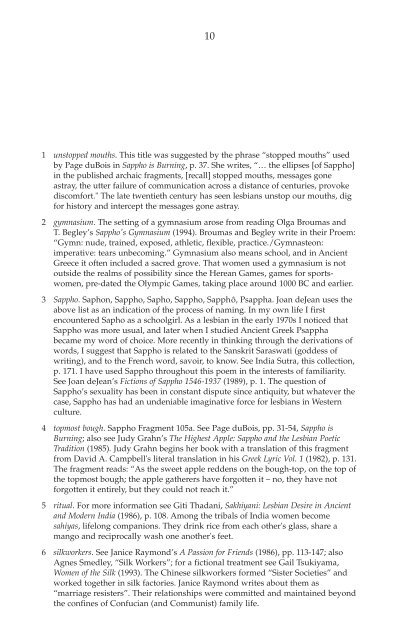Butterfly Effect - ressourcesfeministes
Butterfly Effect - ressourcesfeministes
Butterfly Effect - ressourcesfeministes
You also want an ePaper? Increase the reach of your titles
YUMPU automatically turns print PDFs into web optimized ePapers that Google loves.
10<br />
1 unstopped mouths. This title was suggested by the phrase “stopped mouths” used<br />
by Page duBois in Sappho is Burning, p. 37. She writes, “… the ellipses [of Sappho]<br />
in the published archaic fragments, [recall] stopped mouths, messages gone<br />
astray, the utter failure of communication across a distance of centuries, provoke<br />
discomfort." The late twentieth century has seen lesbians unstop our mouths, dig<br />
for history and intercept the messages gone astray.<br />
2 gymnasium. The setting of a gymnasium arose from reading Olga Broumas and<br />
T. Begley’s Sappho's Gymnasium (1994). Broumas and Begley write in their Proem:<br />
“Gymn: nude, trained, exposed, athletic, flexible, practice./Gymnasteon:<br />
imperative: tears unbecoming.” Gymnasium also means school, and in Ancient<br />
Greece it often included a sacred grove. That women used a gymnasium is not<br />
outside the realms of possibility since the Herean Games, games for sportswomen,<br />
pre-dated the Olympic Games, taking place around 1000 BC and earlier.<br />
3 Sappho. Saphon, Sappho, Sapho, Sappho, Sapphô, Psappha. Joan deJean uses the<br />
above list as an indication of the process of naming. In my own life I first<br />
encountered Sapho as a schoolgirl. As a lesbian in the early 1970s I noticed that<br />
Sappho was more usual, and later when I studied Ancient Greek Psappha<br />
became my word of choice. More recently in thinking through the derivations of<br />
words, I suggest that Sappho is related to the Sanskrit Saraswati (goddess of<br />
writing), and to the French word, savoir, to know. See India Sutra, this collection,<br />
p. 171. I have used Sappho throughout this poem in the interests of familiarity.<br />
See Joan deJean’s Fictions of Sappho 1546-1937 (1989), p. 1. The question of<br />
Sappho’s sexuality has been in constant dispute since antiquity, but whatever the<br />
case, Sappho has had an undeniable imaginative force for lesbians in Western<br />
culture.<br />
4 topmost bough. Sappho Fragment 105a. See Page duBois, pp. 31-54, Sappho is<br />
Burning; also see Judy Grahn’s The Highest Apple: Sappho and the Lesbian Poetic<br />
Tradition (1985). Judy Grahn begins her book with a translation of this fragment<br />
from David A. Campbell's literal translation in his Greek Lyric Vol. 1 (1982), p. 131.<br />
The fragment reads: “As the sweet apple reddens on the bough-top, on the top of<br />
the topmost bough; the apple gatherers have forgotten it – no, they have not<br />
forgotten it entirely, but they could not reach it.”<br />
5 ritual. For more information see Giti Thadani, Sakhiyani: Lesbian Desire in Ancient<br />
and Modern India (1986), p. 108. Among the tribals of India women become<br />
sahiyas, lifelong companions. They drink rice from each other's glass, share a<br />
mango and reciprocally wash one another's feet.<br />
6 silkworkers. See Janice Raymond’s A Passion for Friends (1986), pp. 113-147; also<br />
Agnes Smedley, “Silk Workers”; for a fictional treatment see Gail Tsukiyama,<br />
Women of the Silk (1993). The Chinese silkworkers formed “Sister Societies” and<br />
worked together in silk factories. Janice Raymond writes about them as<br />
“marriage resisters”. Their relationships were committed and maintained beyond<br />
the confines of Confucian (and Communist) family life.

















